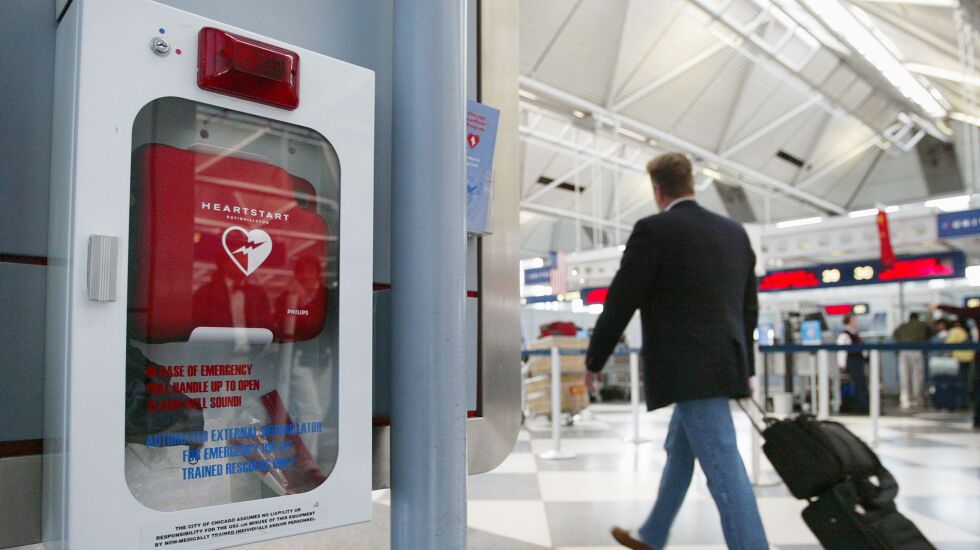
Witnessing Buffalo Bills football player Damar Hamlin’s collapse on the field recently from a cardiac arrest during the Monday Night Football game versus the Cincinnati Bengals was difficult for me to watch, as a health care provider and mother.
But as a registered nurse at a major metropolitan hospital with more than 15 years of experience, I have witnessed first-hand how the early initiation of cardiopulmonary resuscitation (CPR) and use of an automated defibrillator (AED) can make a big difference in outcomes.
Hamlin is recovering and was quickly attended to by trained medical personnel. But in one year alone, more than 350,000 Americans will experience a cardiac arrest, which is fatal more than 90% of the time. And 70% of all cardiac arrests will occur outside a hospital or health care setting.
Death can result within minutes from cardiac arrest if proper steps — such as performing CPR and using an AED to shock the heart and restore a normal heart rhythm — are not taken immediately. Trained, non-medical personnel can initiate CPR and use AEDs, which use voice prompts, lights and messages to walk bystanders through the steps.
National standards regarding CPR training in high school and expansion to elementary schools can improve survival rates outside hospitals. Students are the next generation of bystanders who can provide CPR and AED use, and are more likely to be in homes or the community where cardiac arrests commonly occur.
In 2014, Illinois led the way in passing legislation to require high school students be trained in both CPR and use of an AED. Hospitals across the state have worked to expand education and provision of resources through such programs as ProjectADAM (Automated Defibrillators in Adam’s Memory), a nationwide initiative begun by a family whose son died from sudden cardiac arrest while playing high school basketball.
ProjectADAM works in partnership with Ann & Robert H. Lurie Children’s Hospital of Chicago to provide AEDs to schools and help them achieve Heart Safe School designation, which indicates that students and staff have been trained in CPR and AED usage and that the school has a documented and rehearsed Cardiac Emergency Response Plan.
While Illinois has initiatives, national requirements for employers to provide CPR and AED training, while also providing access to AEDs, is another critical step.
The American Heart Association reports more than 10,000 cardiac arrests occur annually in the workplace, yet 51% of employees cannot identify the location of an AED in the building. Early initiation of CPR and AEDs can double or triple the chance of survival.
In 2012, Illinois had some of the lowest outcomes associated with out-of-hospital cardiac arrests. The state took several steps to improve outcomes.
In 2013, the Illinois Heart Rescue launched, in partnership with the Illinois Department of Public Health (IDPH), with a goal to reduce health disparities in cardiac arrest outcomes by using “hot spotting” to identify and intervene in communities with the highest incidence of cardiac arrest and poor outcomes. Since its inception, Illinois Heart Rescue has trained more than 24,300 community members on hands-only CPR and AED use.
Since then, the rate of bystanders administering CPR in Chicago increased from 13% in 2013 to 24% in 2015, while survival rates for cardiac arrests occurring outside hospitals doubled.
Nationally, requirements for CPR training and placement of AEDs are regulated by states as well as through the Occupational Health & Safety Administration (OHSA). This has led to a large gap between current knowledge of CPR quality and what the optimal implementation should be — which in turn leads to preventable deaths from cardiac arrest.
OSHA’s guidelines on CPR training in the workplace are not very detailed and only require employees to be CPR-certified in certain cases. But OSHA can do more to encourage workplace certification.
The NFL has championed programs to increase education and awareness and improve early detection of cancer through its “Crucial Catch” initiative. And during week 13 of the regular season, players can participate in “My Cause, My Cleats,” an initiative to highlight the charitable organization they support.
As Hamlin recovers and the NFL moves forward from this incident, there should be a new call to action — a “Crucial Play,” as I would call it — in which everyone is encouraged to become CPR-certified.
Molly Moran, MSN, RN, CCRN, is the senior director of ambulatory clinical practice and workforce development at Rush University Medical Center and a Public Voices Fellow of The OpEd Project.
The Sun-Times welcomes letters to the editor and op-eds. See our guidelines.
The views and opinions expressed by contributors are their own and do not necessarily reflect those of the Chicago Sun-Times or any of its affiliates.







